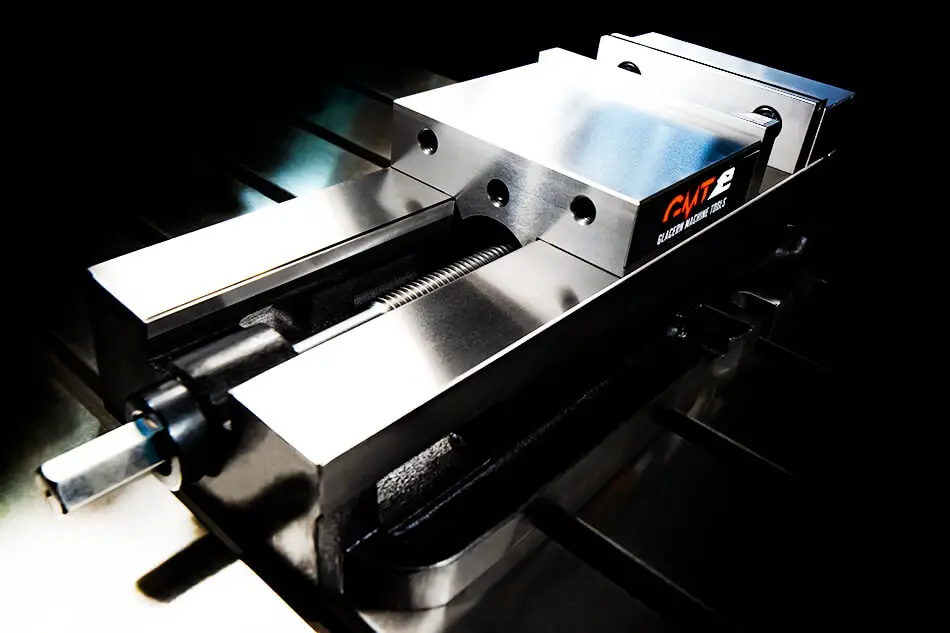Introduction to Types of Machining Vises
A machining vise can be used as a manual component or a machining tool. It is a mechanical device used to hold a workpiece steady during machining. Many traditional production facilities use machining vises for tasks that require precise machining and tight tolerances.
Manual vises have several advantages, but machining vises are generally better suited to hold a workpiece still during high-speed machining. Since high-speed machining can generate huge vibrations, machining vises are designed to reduce vibrations and provide superior stability.
Table of Contents
1.What is a machining vise?
The term“machining vise”refers to a clamping device used on machine tools, typically made of high-strength steel or cast iron. It features two parallel jaws, one fixed and the other movable, operated by a screw mechanism to open and close. During milling, drilling, or grinding operations, it firmly holds the workpiece in place, preventing movement that could reduce accuracy. With its stable structure and repeatable positioning, the machining vise is an essential and widely used tool in workshops.
When we refer to vises in the remaining paragraphs of this article, we are referring to tools with fixed and movable jaws. Fortunately or unfortunately, there are still many options when choosing a vise. These are the vises we considered for our CNC milling machine.
To help you choose the ideal vise for your machine, we also provide evaluation criteria. Different vises may work better in your application.
2.Types of Machining Vises
There are many types of machining vises. The main types are introduced below.
The 18 types of machining vises include:
- Machinist vises
- CNC vises
- Tool vises
- Pipe vises
- Flange machine vises
- Universal machine vises
- Vertical machine vises
- Rotating machine vises
- Metalworking vises
- Woodworking vises
- Heavy duty vises
- Medium bench vises
- Chain vises
- Yoke vises
- Leg vices
- Hand vises
- Combination hand vises
- Pin vises
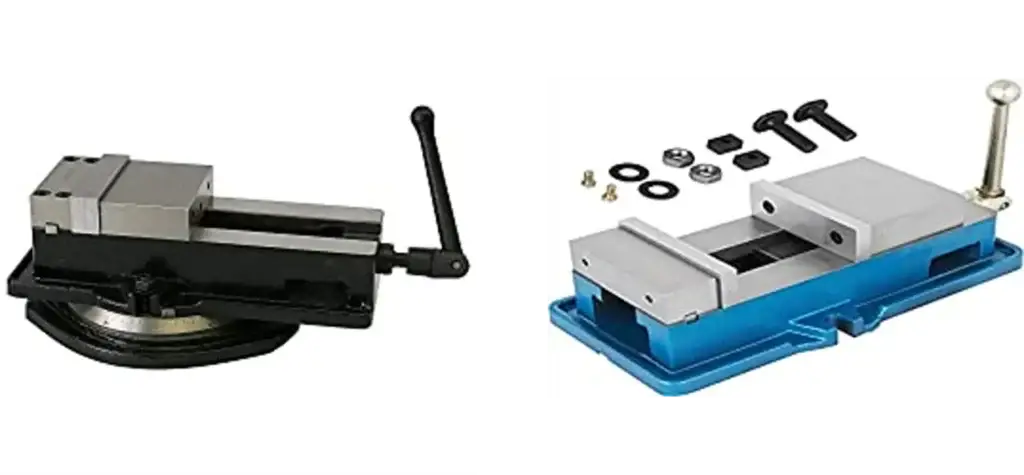
1) Machinist vises
These are the traditional vises commonly found on many manual milling machines. The vise can be fixed to the milling machine table using the flange on the side, which is a simple and practical solution. The downside to these vises is that they take up more space on your milling machine’s table than the other options discussed below.
These vises come in two variations: one with a swivel base and one with a permanent base. They are both great choices for entry-level vises.
2) CNC vises
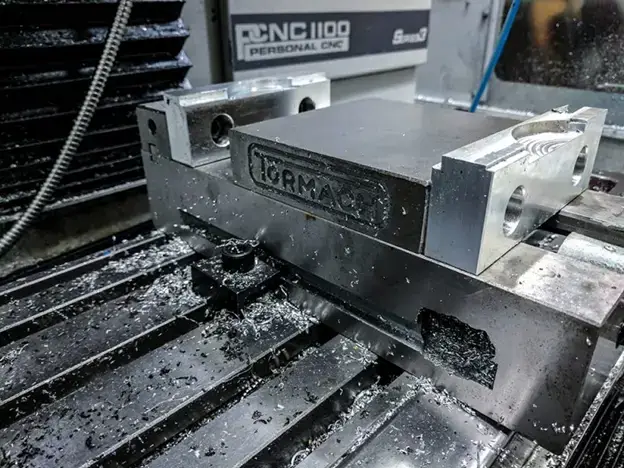
CNC vises are able to meet the challenges of mechanical vises by using a more compact design but offering the same strong holding power as mechanical vises. Because of their smaller size, a greater number of vises can be used simultaneously in a smaller space.
Multiple sides of CNC vises are precision ground so they can clamp horizontally and sideways. Although it can be a little tricky to secure them to the table without flanges, this vise comes with a specialized table clamp that can handle this. CNC vises also come in a locking design.
3) Toolmaking vises
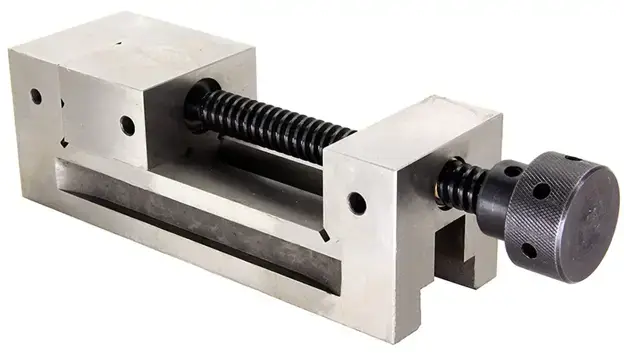
Toolmaking vises are more difficult to operate, but are smaller, cheaper, and more accurate. This is because they are tightened using multi-stage latches instead of long screws. Toolmaking vises are often used when workpieces need to be transferred from one machine to another.
Without damaging the workpiece, you can leave it in a small tool-making machine and transfer it to other equipment such as a drill press, milling machine, surface grinder or larger machinist vise.
A tool-making vise does not usually include accessories such as interchangeable jaws or work stops like machinist and CNC vises, but it uses a similar locking design to prevent the jaws from rising.
4) Pipe clamp
When doing plumbing work, a pipe clamp is used to hold pipes while cutting or threading them. It can accommodate pipe clamps with a diameter of 200 mm or as small as 3 mm. It can be mounted on a workbench or used with a portable tripod.
Lightweight and easily transportable mobile tripods are often used for work that needs to be done outside the workplace. Longer pipes can be created by combining two or more.
5) Flange machine vise
Heavy duty machinist vise is another name for a flange machinist vise. This type of machinist vise is used to hold items that often subject the operator to shock during machining. One end of the spindle is fitted with a square end and a box handle is fixed to turn the spindle.
6) Universal Machine Vise
This type of machine vise is very practical and is used frequently. The advantage of this type of machine vise is that it can work in a variety of directions, including horizontal, vertical, and angled. It is mainly used for production tools.
7) Vertical Machine Vise
Vertical machine vise is different from all other vises. As the name implies, the workpiece in this vise is clamped vertically. This vise does not have jaws, but has flanges. It is very simple to use.
8) Rotary Machine Vise
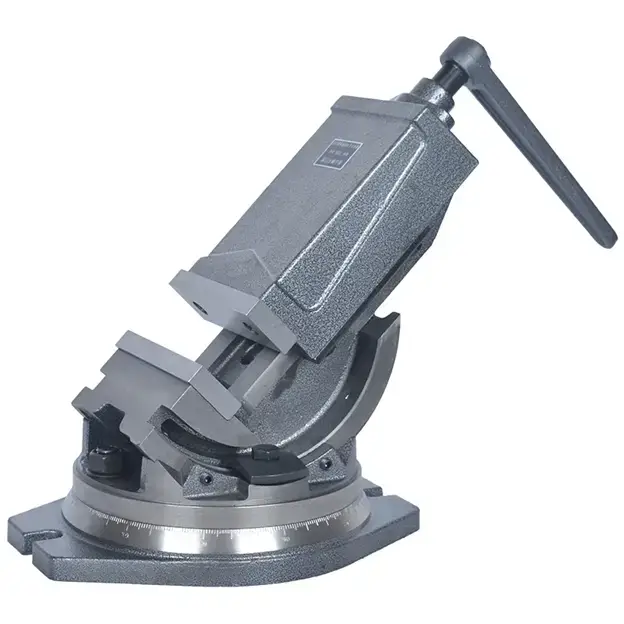
The rotary machine vise is similar to the flange machine vise in construction and structure, but it has a different type of base that allows the vise to rotate to any angle. The advantage is that straight or angled work can be performed without removing the task from the vise.
9) Metalworking Vise
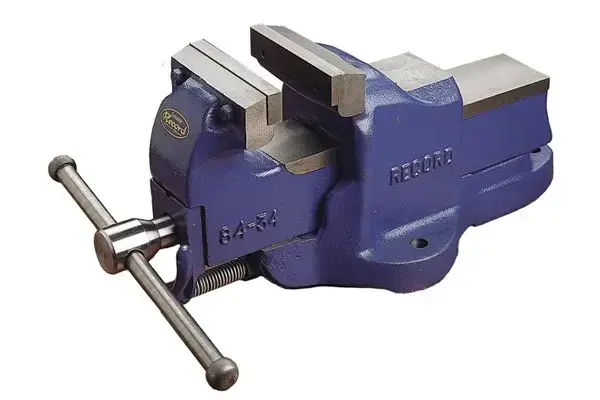
These vises are often called machinist vises or engineer vises. It keeps the metal parts in place. The slotted bars of metalworking vises are made of steel, although the vise is mainly made of cast iron.
Cast iron is chosen because it is strong, durable, and affordable. Typically, metalworking vises are used for processes like cutting and filing.
The jaws of this type of metalworking vise are usually removable within the unit so that they can be replaced. The jaws of metalworking vises are coated with soft materials such as aluminum, wood, copper, or plastic and are used for delicate work. The purpose of this is to protect the contents.
Typically, a metalworking vise is fixed to a workbench with the front of the jaws extending just to the front edge. Behind the vise body of a metalworking vise, there may be a small anvil.
10) Woodworking vise
This type of vise is used in woodworking workshops. The jaws are used when making this type of vise. To clamp the workpiece securely, one jaw grabs the workpiece while the other jaw rests against the workpiece. The jaws can be securely operated by a screw mechanism.
Wood, plastic, and metal are commonly used to make woodworking vises. Depending on the precise task that has to be completed, it has to be done.
11) Heavy duty vise
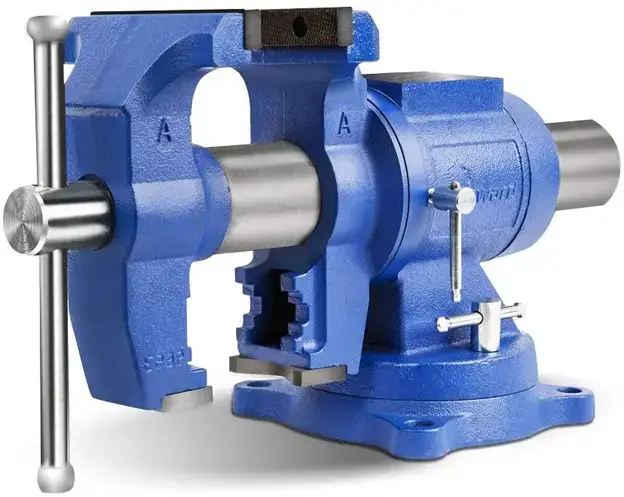
Heavy duty bench vise is mainly made of iron so that it can withstand heavy use. Split steel jaws, an ACME threaded master screw, and a precision slide bar are the components of a heavy duty bench vise. A sturdy bench vise rests on a fixed platform.
12) Medium Duty Bench Vise
The heavy duty bench vise mentioned earlier is closely related to the medium duty bench vise. Additionally, the heavy duty bench vise is made of iron and offers the option of replacing the steel upper jaw. Some of these jaws also include an integrated anvil and a 360 degree swivel.
13) Chain Vise
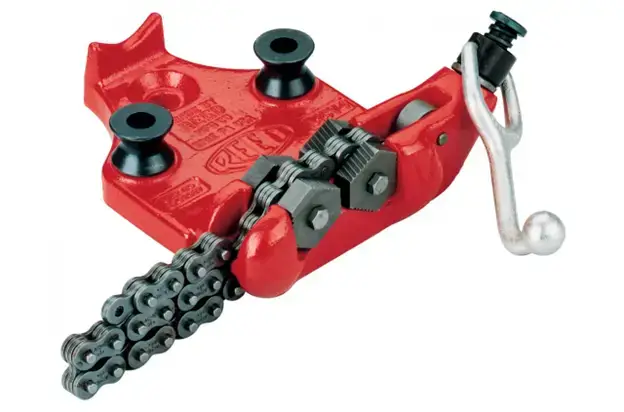
The chain is used to hold the pipe in the chain vise. The clamping effectively maintains the V-shape of the pipe. To fit perfectly with uneven pipes or other items, this chain is made of high tensile strength steel.
Since the length of the chain limits the working range of the vise, chain vises tend to have a wider working range and a larger capacity. The large clamping area of the chain determines the entire circumference of the pipe.
One of the main disadvantages of chain vises is that it takes longer to hold a pipe with a chain vise than with other types of vises, as the chain needs to be carefully and correctly passed between the jaws of the tool to clamp the pipe securely.
14) Yoke vise
Yoke vise, also known as hinge vise or adjustable jaw vise, uses screws to hold the pipe in place. The vise can hold the pipe securely due to the movable upper jaw and the V-shaped lower jaw. These jaws have serrations to hold the object firmly.
15) Leg vice
Leg vise is commonly used in blacksmith shops. Forging tasks such as forging, bending and other processes are done while the hot workpiece is fixed in it. It is hung on the workbench in this way.
It has only one leg and can be immediately mounted on the wood. A hinge connects the two jaws (fixed jaw and movable jaw) together. The movable jaw handle opens easily when it is rotated with the help of a strong spring leaf placed between the two jaws. A spindle is mounted on the top of both jaws, which has square threads on it.
When the handle is turned, a nut box is inserted, which allows the movable jaw to open outward. The entire body is made of hard iron. Therefore, when we hit it with a hammer, it explodes without causing any harm.
16) Hand vise
This vise has long legs, similar to the leg vise, and opens in a similar way to the leg vise. This vise allows only smaller-sized jobs.
It cannot be fixed to the workstation, but held in the hand, as its name suggests. The wing nut is a point on the spindle located between the two jaws, which is used in place of the handles (fixed handle and movable handle). Since the spring load is fixed, it can be opened easily.
17) Combination hand vise
Combination hand vise can be used as both a hand vise and a small bench vise. It can be used as a hand vise in actual use. It also comes with a base clamp. It can also be mounted to the workbench with the help of this clamp. In this way, it can be used as a small bench vise.
Its unique selling point is that, just like a swivel vise, it can be mounted to any desired angle by simply loosening the wing nut. Here, steel forging technology is used to make a combination hand vise. The threads on the left and right sides of the spindle are cut. Therefore, both jaws can be easily opened or closed at the same time.
18) Pin vise
The pin vise functions like a small drill chuck. Similar to the chuck in the pin vise, there are three jaws. The upper part is elongated and has six or eight panes. The hole in the vise body is used to store cables or pins.
The pin vise can be opened and closed by force by hand. Watchmakers or instrument makers can use it to fix screws, pins, etc.
3.What factors should I consider when choosing a machining vise?
When selecting a machining vise, users need to determine whether it is suitable based on the workpiece characteristics and processing requirements.
- Size Compatibility: Jaw width and opening range are primary considerations. Ensure that it can clamp both large and small workpieces.
- Accuracy Requirements: The parallelism and squareness of the vise directly determine the accuracy of the finished workpiece. If high-precision parts are required, choose a model that has been precision-ground and tested.
- Functional Expansion: Some processes require cutting at multiple angles or bevels. In these cases, a vise with a rotating or tilting base can provide increased flexibility.
- Material and Clamping Force: High-strength steel or cast iron vises are more suitable for heavy cutting conditions. Aluminum or softer materials require soft jaws to avoid damage.
- Machine Tool Compatibility: The mounting method must align with the T-slot or mounting hole position of the machine table; otherwise, clamping stability will be affected.
4.How do I properly install a machining vise?
Proper vise installation is crucial for machining accuracy and safety. The general process is as follows:
- Securing the vise: Tighten the vise base to the T-slot on the machine table, securing it with bolts.
- Adjusting parallelism: Use a feeler gauge or dial indicator to check the parallelism of the vise jaws to the machine spindle feed direction, and adjust the position by slightly moving the vise.
- Confirming the tightening: After adjusting the position, tighten the bolts thoroughly to prevent the vise from shifting during machining.
- Test cutting: Before the actual machining, perform a light cut to confirm that the workpiece clamping and parallelism meet the requirements.
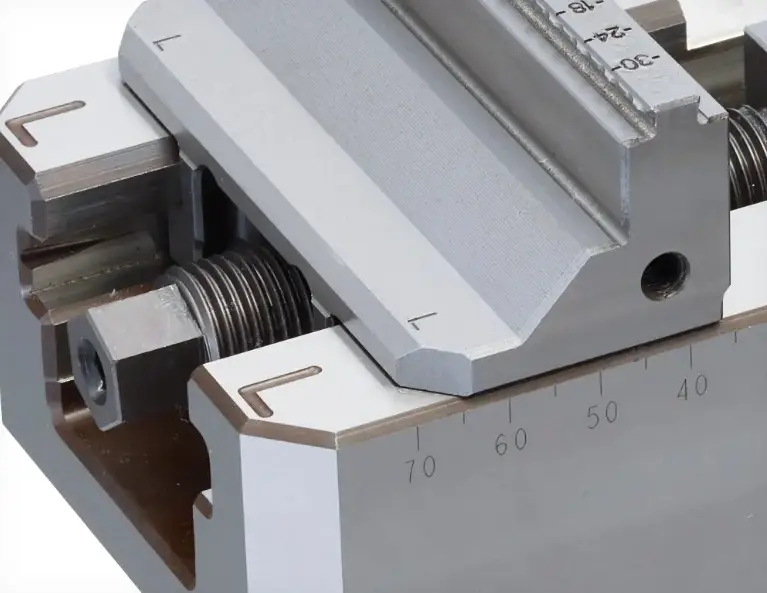
5.How to maintain and service a machining vise?
To extend the life of the vise and maintain its accuracy, establish daily maintenance habits:
- Cleaning: Immediately remove chips and coolant after machining to prevent them from accumulating between the guide rails and lead screws and causing wear.
- Lubrication: Regularly apply lubricant to the lead screw and guide rails to maintain smooth movement.
- Inspection: Regularly check the parallelism and squareness of the jaws. If any deviation is detected, adjust or replace them promptly.
- Correct Use: Avoid over-tightening the workpiece to prevent deformation of the vise body or lead screw.
This effectively prevents performance degradation and keeps the vise in optimal condition for a long time.
6.What are some common problems with machining vises?
In actual use, vises may exhibit the following common issues:
- Workpiece still shakes after clamping → This may indicate worn jaws or uneven clamping surfaces. Replace or install soft jaws.
- Long workpieces are difficult to secure stably → Use two vises to clamp simultaneously or use specialized fixtures to distribute the force.
- Workpiece surface is bruised → Use aluminum or copper soft jaws or insert protective spacers between the jaws and the workpiece.
- The vise moves unsmoothly → Clean and relubricate the guide rails and lead screw. Inspect for mechanical damage if necessary.
Promptly identifying and resolving these issues can significantly improve machining efficiency and workpiece quality.
7.What are the applications of machining vises?
Machining vises are primarily used to secure workpieces during machine tool operation, ensuring stability and precision during machining. Common applications include:
- Milling: Secures metal or plastic workpieces on vertical or horizontal milling machines for surface machining, grooves, and holes.
- Drilling and Tapping: Clamps parts in drilling machines or machining centers to prevent drill bit deflection or workpiece movement.
- Grinding: Positions workpieces on precision grinding machines to maintain surface flatness.
- CNC machining centers: Coupled with automated positioning systems, vises enable rapid workpiece clamping and improve machining cycle time.
- Precision Measurement and Assembly: Temporarily secures parts during inspection and assembly, facilitating positioning and adjustment.
In addition, vises have specialized applications in various industries, such as part clamping in mold manufacturing, precision positioning of aerospace parts, and securing small workpieces in scientific research experiments.
8.Summary
Vises are one of the most common and practical tools for machining. Whether it’s milling, drilling, or precision machining, it’s practically everywhere. Choosing the right vise can also reduce unnecessary headaches for machining professionals, such as workpiece slippage, surface damage, and misalignment, ensuring a more stable and worry-free machining process.
Choosing the right vise is crucial, as is choosing the right machining partner.
Just as a vise secures the workpiece during machining, Xavier’s goal is to provide a solid foundation for our customers’ products. With over a decade of experience in CNC machining, we are familiar with the machining requirements of a wide range of materials and complex components. Leveraging advanced equipment and comprehensive quality inspection processes, we have provided reliable parts solutions to clients in multiple countries and industries, earning the trust of long-term partners. If you’re looking for a trustworthy CNC machining partner, we welcome your inquiries.
FAQs:
What is a machining vise?
A machining vise is a workpiece clamping device designed for machine tools. It typically consists of a fixed jaw and a movable jaw. It clamps the workpiece using a screw/lever mechanism to prevent displacement and minimize vibration during machining, thereby improving machining accuracy and safety.
What are the key differences between machining vises and standard bench vises?
Machining vises emphasize parallelism, squareness, and repeatability, and feature higher material and manufacturing precision, making them suitable for milling machines, CNC machines, and other cutting applications. Standard bench vises, on the other hand, are more general-purpose or for manual operations, with coarser guides and tolerances, making them unsuitable for high-precision machining. It is recommended not to use a standard bench vise in place of a machining vise for precision cutting.
When should a CNC vise be used? How does it differ from a standard machine vise?
A CNC vise is more suitable when fast clamping, automated loading and unloading, or high repeatability are required in a machining center. CNC vises are typically compact, multi-faceted, and easy to clamp and position, and can be easily integrated with automated fixtures. Standard machine vises are more versatile and bulky.
What can I do if a long workpiece is difficult to secure? Are there any practical solutions?
Common methods include using two vises of the same height side by side for support (either one behind the other or side by side), using support blocks or parallel irons to share the load, or customizing clamps/jigs to stabilize the long workpiece. For mass production, consider specialized multi-position fixtures to improve efficiency and stability.
Vises can damage workpiece surfaces. How can workpieces be protected?
Common measures include using soft jaws (aluminum, copper, or engineering plastics) or inserting protective washers between the jaws and the workpiece. For thin-walled or finely machined surfaces, soft jaws are preferred, and the clamping force should be controlled to avoid excessive compression.
Can vises replace specialized fixtures? When is a specialized fixture essential?
Vises are suitable for general-purpose clamping and small- to medium-volume machining. However, for complex shapes, those requiring extremely precise positioning, or large-scale production, specialized fixtures provide greater consistency and efficiency. If machining accuracy, positioning datums, or clamping cycle time are critical, jigs/specialized fixtures should be considered.
